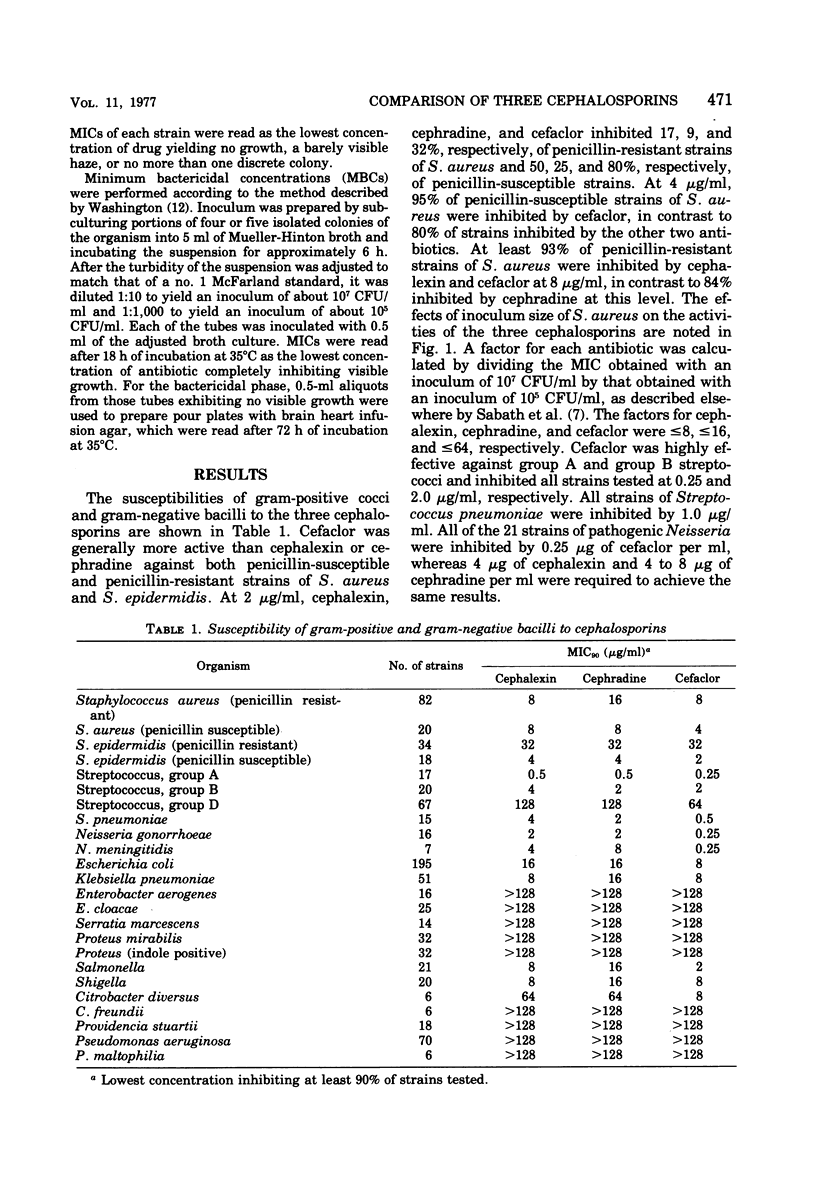Abstract
Inhibitory activity of cephalexin, cephradine, and cefaclor was compared by the WHO-ICS agar dilution technique. Cefaclor was substantially more active against staphylococci, streptococci, gonococci, meningococci, Haemophilus, Escherichia coli, Klebsiella pneumoniae, Citrobacter diversus, Proteus mirabilis, salmonellae, and shigellae than was cephalexin, which in turn was more active than cephradine. Cefaclor appeared to be less resistant to staphylococcal penicillinase than did the other two agents. None of these cephalosporins was active against Enterobacter, Serratia, indole-positive Proteeae, Pseudomonas, or Bacteroides fragilis.
Full text
PDF




Selected References
These references are in PubMed. This may not be the complete list of references from this article.
- Emerson B. B., Smith A. L., Harding A. L., Smith D. H. Hemophilus influenzae type B susceptibility to 17 antibiotics. J Pediatr. 1975 Apr;86(4):617–620. doi: 10.1016/s0022-3476(75)80166-1. [DOI] [PubMed] [Google Scholar]
- Fong I. W., Engelking E. R., Kirby W. M. Relative inactivation by Staphylococcus aureus of eight cephalosporin antibiotics. Antimicrob Agents Chemother. 1976 Jun;9(6):939–944. doi: 10.1128/aac.9.6.939. [DOI] [PMC free article] [PubMed] [Google Scholar]
- Hubsher J. A., Gadebusch H. H., Itkin A. G. Double-blind comparison of cephradine and cephalexin in the treatment of skin and soft-tissue infections due to Staphylococcus aureus. Curr Ther Res Clin Exp. 1976 Jun;19(6):579–588. [PubMed] [Google Scholar]
- Klastersky J., Daneau D., Weerts D. Cephradine. Antibacterial activity and clinical effectiveness. Chemotherapy. 1973;18(3):191–204. doi: 10.1159/000221261. [DOI] [PubMed] [Google Scholar]
- McGowan J. E., Jr, Garner C., Wilcox C., Finland M. Antibiotic susceptibility of gram-negative bacilli isolated from blood cultures. Results of tests with 35 agents and strains from 169 patients at Boston City Hospital during 1972. Am J Med. 1974 Aug;57(2):225–238. doi: 10.1016/0002-9343(74)90447-1. [DOI] [PubMed] [Google Scholar]
- Sabath L. D., Garner C., Wilcox C., Finland M. Effect of inoculum and of beta-lactamase on the anti-staphylococcal activity of thirteen penicillins and cephalosporins. Antimicrob Agents Chemother. 1975 Sep;8(3):344–349. doi: 10.1128/aac.8.3.344. [DOI] [PMC free article] [PubMed] [Google Scholar]
- Scholand J. F., Hodges G. R., Fass R. J., Saslaw S. Clinical evaluation of cephradine, a new oral cephalosporin. Am J Med Sci. 1974 Feb;267(2):111–116. doi: 10.1097/00000441-197402000-00005. [DOI] [PubMed] [Google Scholar]
- Thornsberry C., Kirven L. A. Antimicrobial susceptibility of Haemophilus influenzae. Antimicrob Agents Chemother. 1974 Nov;6(5):620–624. doi: 10.1128/aac.6.5.620. [DOI] [PMC free article] [PubMed] [Google Scholar]
- Washington J. A., 2nd, Snyder R. J., Kohner P. C. Spurious ampicillin resistance by testing Haemophilus influenzae with agar containing supplement C. Antimicrob Agents Chemother. 1976 Jan;9(1):199–200. doi: 10.1128/aac.9.1.199. [DOI] [PMC free article] [PubMed] [Google Scholar]


